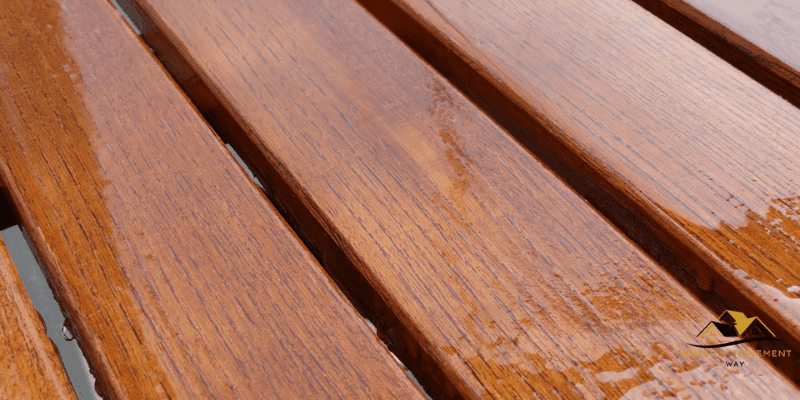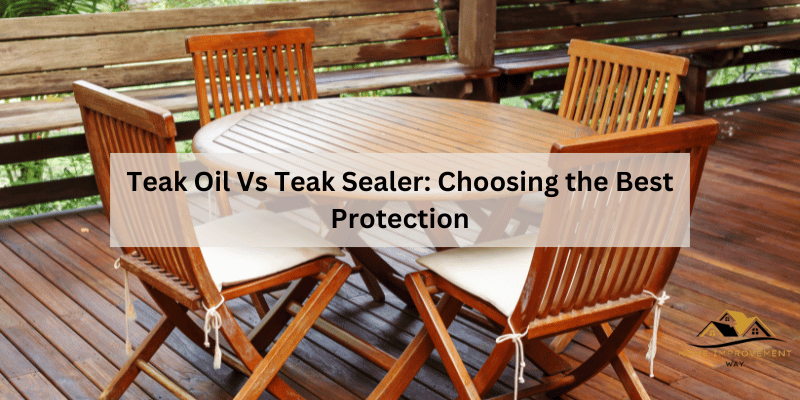Teak oil enhances natural wood appearance and provides UV protection, while teak sealer forms a protective barrier against weathering and discoloration. Teak oil and teak sealer are popular choices for protecting and preserving teak wood furniture and outdoor fixtures.
Both products offer distinct advantages and it’s important to understand their differences to make an informed decision. Teak oil penetrates wood, bringing out its natural beauty and providing protection from UV rays, while teak sealer forms a protective layer on the surface to shield the wood from weathering and discoloration.
Understanding the unique benefits of each product can help you choose the right option for your specific needs. Whether you are looking to enhance the natural appearance of your teak furniture or provide durable protection against the elements, knowing the differences between teak oil and teak sealer is crucial.
Benefits Of Teak Oil Treatment
Teak oil treatment offers a range of benefits that not only enhance the appearance of teak wood but also prolong its lifespan. The natural finish, UV protection, and overall nourishing properties make teak oil an ideal choice for maintaining and preserving outdoor teak furniture.
Natural Finish
Teak oil treatment provides a natural and warm finish to the wood, enhancing its natural beauty. This allows the wood grain to shine through, creating an aesthetically pleasing appearance. The application of teak oil also helps bring out the rich brown tones of teak wood, adding warmth and depth to the furniture.
Uv Protection
Teak oil contains additives that provide UV protection for the wood, helping to prevent it from fading and greying due to sun exposure. This is particularly beneficial for outdoor teak furniture that is constantly exposed to the elements. With regular application of teak oil, the wood is shielded from the damaging effects of sunlight, maintaining its original color and finish over time.
Drawbacks Of Teak Oil
When considering the maintenance of teak furniture, it’s essential to weigh the drawbacks before making a decision. While teak oil is a popular choice for preserving the natural beauty of teak wood, it comes with its own set of limitations. Understanding the drawbacks of teak oil is crucial in making an informed choice for the care of your teak furnishings.
Shortevity
Teak oil provides rich, natural color to teak wood and can enhance its appearance. However, one of its major drawbacks is its shortevity. Teak oil tends to break down relatively quickly, especially when exposed to outdoor elements. The frequent need for reapplication can be both time-consuming and costly. Moreover, the frequent reapplication can result in an uneven finish, detracting from the overall aesthetics of the teak furniture.
Regular Maintenance
Another drawback of using teak oil is the demand for regular maintenance. Due to its short longevity, teak oil requires frequent reapplication to uphold the protective layer on the wood. This constant upkeep can become a tedious task, especially for large teak furniture collections. The need for regular maintenance with teak oil may not be feasible for those seeking a low-maintenance option for their teak furniture.

Advantages Of Teak Sealer Application
When it comes to protecting and preserving your outdoor teak furniture, applying a teak sealer offers several distinct advantages. Unlike teak oil, which requires frequent reapplication, teak sealer provides long-lasting protection and requires minimal maintenance. In this section, we’ll delve into the advantages of teak sealer application, highlighting its ability to offer extended protection and reduce the need for constant upkeep.
Long-lasting Protection
Teak sealer is highly effective at providing long-lasting protection for your teak furniture. When properly applied, the sealer forms a protective barrier on the surface of the wood, shielding it from the damaging effects of moisture, UV rays, and other environmental elements. This barrier helps to prevent the natural silver-gray patina that forms on untreated teak, thereby maintaining the warm, honey-brown color of the wood for an extended period.
Low Maintenance
One of the key advantages of teak sealer application is its ability to minimize maintenance efforts. Unlike teak oil, which requires regular reapplication every few months, a high-quality teak sealer typically lasts for a year or more, reducing the need for frequent touch-ups. This results in less time and effort spent on maintaining your teak furniture, allowing you to enjoy its beauty without the constant upkeep.
By focusing on the advantages of teak sealer application, this section aims to highlight the benefits of using teak sealer over teak oil. The use of H3 headings and concise, SEO-optimized content helps to present the information in a clear, structured manner, making it easy for readers to understand the benefits of teak sealer for preserving outdoor teak furniture.
Disadvantages Of Teak Sealer
Teak sealers offer several benefits in protecting teak wood furniture, but there are also some notable drawbacks to consider. Understanding the disadvantages of teak sealer can help you make an informed decision on the best method of preserving your teak furniture.
Altered Appearance
One of the primary disadvantages of using a teak sealer is that it can alter the natural appearance of the wood. While teak sealers may provide protection against moisture and UV damage, they often leave a shiny or glossy finish on the wood. This altered appearance may not appeal to those who prefer the natural, matte look of untreated teak.
Required Reapplication
Teak sealers typically require regular reapplication to maintain their protective properties. Over time, the sealer can wear off, especially in outdoor settings where furniture is exposed to the elements. The need for frequent reapplication can be a disadvantage for those seeking a low-maintenance solution for preserving their teak furniture.
Applying Teak Oil
Proper Techniques
When applying teak oil to your furniture, it’s crucial to follow the proper techniques to ensure effective and long-lasting results. Here are the key steps to consider:
- Prepare the surface: Before applying teak oil, make sure the surface is clean and free from dust, dirt, and any previous coatings.
- Apply the oil: Use a clean cloth or brush to apply the teak oil in the direction of the wood grain. Allow the oil to penetrate the wood for a few minutes.
- Wipe off excess oil: After allowing the oil to penetrate, wipe off any excess oil with a clean, dry cloth to prevent a sticky residue.
- Repeat the process: Depending on the condition of the wood, you may need to repeat the application process several times to achieve the desired protection and finish.
Maintenance Tips
After applying teak oil to your furniture, proper maintenance is essential to preserve its beauty. Here are some maintenance tips to prolong the life of your teak furniture:
- Regular cleaning: Wipe the furniture with a damp cloth to remove dust and debris, and avoid using harsh chemicals that may strip away the protective oil.
- Reapply teak oil: Over time, the protective oil may wear off, so it’s important to reapply teak oil as needed to maintain the wood’s luster and protection.
- Protect from the elements: If the furniture is used outdoors, consider using a cover to shield it from direct sunlight, moisture, and other weather conditions.
Using Teak Sealer
When applying teak sealer, it’s important to follow the correct methods to ensure optimal results. Here are some key steps to keep in mind:
- Clean the teak wood surface thoroughly to remove any dirt, grime, or previous coatings. Use a teak cleaner and sand the surface if necessary to ensure a smooth finish.
- Apply the teak sealer evenly using a brush or cloth, following the natural grain of the wood. Allow the sealer to penetrate the wood for the recommended time before wiping off any excess.
- Repeat the application process as needed to achieve the desired level of protection and finish.
Proper long-term care is essential to maintain the effectiveness of teak sealer over time. Here are some tips for ensuring the longevity of your teak wood:
- Regularly clean the teak surface with a mild soap and water to remove any dirt or stains.
- Periodically reapply the teak sealer as recommended by the manufacturer to ensure ongoing protection against moisture, UV rays, and other environmental factors.
- Avoid placing hot items directly on the teak surface and use coasters or trivets to protect the wood from heat damage.
Frequently Asked Questions Of Teak Oil Vs Teak Sealer
What Is The Difference Between Teak Oil And Teak Sealer?
Teak oil penetrates wood to enhance natural color and provide protection, while teak sealer acts as a barrier against moisture and UV rays. Teak oil preserves the wood’s appearance, while teak sealer offers longer protection.
How Often Should I Apply Teak Oil Or Teak Sealer?
It is recommended to apply teak oil every 3-6 months to maintain the wood’s appearance and protection. Teak sealer should be reapplied annually for maximum protection against moisture and UV damage, depending on environmental exposure.
Can Teak Oil Be Used Over Teak Sealer, And Vice Versa?
It is not recommended to apply teak oil over teak sealer, as the sealer creates a barrier that may prevent oil absorption. However, teak sealer can be applied over teak oil to achieve enhanced protection and prolong the wood’s longevity.
Conclusion
The choice between teak oil and teak sealer ultimately depends on your specific needs and preferences. Both products offer effective protection for your teak furniture, but they have different application methods and results. Consider the level of maintenance you are willing to commit to and the desired finish for your teak, and make an informed decision based on those factors.


